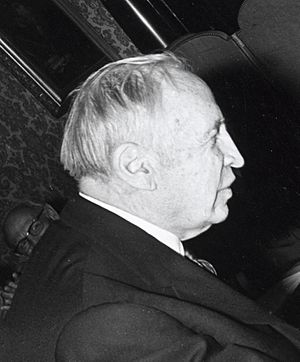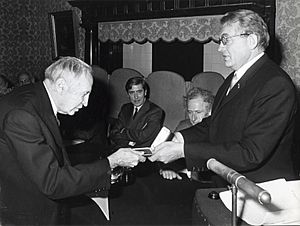John Hasbrouck Van Vleck facts for kids
Quick facts for kids
John Hasbrouck Van Vleck
|
|
|---|---|

John Hasbrouck Van Vleck, 1974
|
|
| Born | March 13, 1899 |
| Died | October 27, 1980 (aged 81) |
| Nationality | United States |
| Alma mater | University of Wisconsin–Madison Harvard University |
| Known for | Van Vleck paramagnetism, Van Vleck transformations, Van Vleck formula |
| Awards |
|
| Scientific career | |
| Fields | Physics |
| Institutions | University of Minnesota University of Wisconsin–Madison Harvard University University of Oxford Balliol College, Oxford |
| Doctoral advisor | Edwin C. Kemble |
| Doctoral students | Robert Serber Edward Mills Purcell Philip Anderson Thomas Kuhn John Atanasoff Arianna Rosenbluth |
John Hasbrouck Van Vleck (born March 13, 1899 – died October 27, 1980) was an American physicist and mathematician. He won the Nobel Prize in Physics in 1977. He shared this award for his important work on how tiny particles called electrons act inside magnetic materials.
Contents
Early Life and Education
John H. Van Vleck was born in Middletown, Connecticut. His father, Edward Burr Van Vleck, was a mathematician. His grandfather, John Monroe Van Vleck, was an astronomer.
John grew up in Madison, Wisconsin. He earned his first college degree, an A.B., from the University of Wisconsin–Madison in 1920. He then went to Harvard University for more studies. He received his Ph.D. degree in 1922.
Career and Discoveries
John H. Van Vleck started his career as an assistant professor at the University of Minnesota in 1923. Later, he moved to the University of Wisconsin–Madison. Eventually, he settled at Harvard University. He also received an honorary degree from Wesleyan University in 1936.
Understanding Magnetism
Van Vleck laid the groundwork for the quantum theory of magnetism. This is a way of understanding how tiny particles behave. He also helped create the crystal field theory, which explains how atoms bond in certain metal compounds. Because of his important work, he is often called the Father of Modern Magnetism.
Work During World War II
During World War II, Van Vleck worked on radar technology. He spent time at the MIT Radiation Lab and also taught at Harvard University.
He discovered that water molecules in the air would absorb radar signals at certain wavelengths (about 1.25 centimeters). He also found that oxygen molecules would absorb signals at 0.5 centimeters. These discoveries were very important. They helped improve military radar systems. They also later helped develop radioastronomy, which uses radio waves to study space.

Van Vleck also took part in the Manhattan Project. This was a secret project to develop the first nuclear weapons. In 1942, he joined a group of scientists at the University of California, Berkeley. They studied how to design an atomic bomb.
His work helped lead to the creation of the Los Alamos National Laboratory. This lab was where the first atomic bombs were built. In 1943, he served on a committee that reviewed the Los Alamos project. This committee helped make the "Little Boy" atomic bomb smaller and faster to produce. This bomb was later used in Hiroshima.
Later Career and Legacy
From 1961 to 1962, Van Vleck was a visiting professor at the University of Oxford in England. He also held a teaching position at Balliol College, Oxford.
In 1950, he became a foreign member of the Royal Netherlands Academy of Arts and Sciences. He received the National Medal of Science in 1966 and the Lorentz Medal in 1974.
In 1977, John H. Van Vleck won the Nobel Prize in Physics. He shared it with Philip Warren Anderson and Sir Nevill Francis Mott. They were honored for their work on how electrons behave in magnetic solids. Several scientific ideas are named after him, including Van Vleck transformations, Van Vleck paramagnetism, and the Van Vleck formula.
John H. Van Vleck passed away in Cambridge, Massachusetts, when he was 81 years old.
Awards and Honors
John H. Van Vleck received many important awards for his scientific work:
- Irving Langmuir Award (1965)
- National Medal of Science (1966)
- Foreign Member of the Royal Society (1967)
- Elliott Cresson Medal (1971)
- Lorentz Medal (1974)
- Nobel Prize in Physics (1977)
Personal Life
John H. Van Vleck and his wife, Abigail, were passionate art collectors. They especially loved Japanese woodblock prints, known as Ukiyo-e. This collection, called the Van Vleck Collection, was passed down from his father. In the 1980s, they donated it to the Chazen Museum of Art in Madison, Wisconsin.
See also
 In Spanish: John Hasbrouck van Vleck para niños
In Spanish: John Hasbrouck van Vleck para niños

